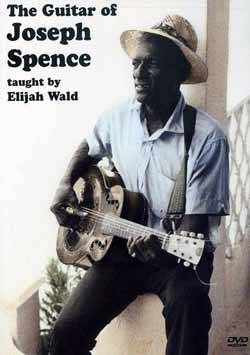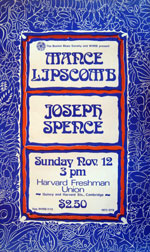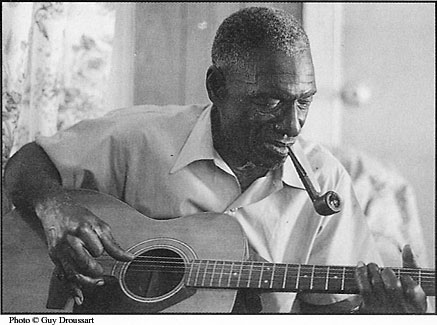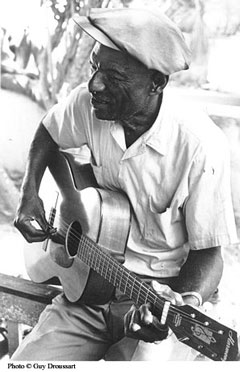 I saw Joseph Spence only once, when I was 12 years old, in a concert at Harvard University with the Texas guitarist Mance Lipscomb. I can't say I
remember very much about that particular concert, but I have been listening
to his music as long as I can remember, and he has always been one of
my favorite musicians. I worked out one of his arrangements for the
first time in the late 1970s, among the first pieces I ever tried to
learn note for note off a recording. I can't say I got very close to
his fingering, but I came pretty close to the rhythm, and that was what
first fascinated me about his playing. I was used to the straightforward
rhythms of ragtime-blues, and Spence opened up new possibilities that
would eventually lead me to the Congo and lessons from players like
Jean-Bosco Mwenda and Edouard Masengo.
I saw Joseph Spence only once, when I was 12 years old, in a concert at Harvard University with the Texas guitarist Mance Lipscomb. I can't say I
remember very much about that particular concert, but I have been listening
to his music as long as I can remember, and he has always been one of
my favorite musicians. I worked out one of his arrangements for the
first time in the late 1970s, among the first pieces I ever tried to
learn note for note off a recording. I can't say I got very close to
his fingering, but I came pretty close to the rhythm, and that was what
first fascinated me about his playing. I was used to the straightforward
rhythms of ragtime-blues, and Spence opened up new possibilities that
would eventually lead me to the Congo and lessons from players like
Jean-Bosco Mwenda and Edouard Masengo.
 Over the next thirty
years I learned about a dozen of his pieces, but it was only after Ernie
Hawkins put me in touch with Stefan Grossman and Stefan agreed to do
this video that I really buckled down and tried to get the pieces right.
The last three years have involved months of intensive woodshedding,
as well as many long conversations with Guy Droussart. Guy was a friend
of Spence's and knows his style better than anyone alive. Every
time I would think I had it right, I'd send Guy
a recording or play something for him over the phone, and he would tell
me I still had it all wrong. Guy believes that no one can truly play
Spence's style unless they have a deep immersion in Bahaman church singing,
then develop the physical strength Spence had from years as a stonemason.
I agree with him, but also feel that there is a great deal to be learned
by understanding how Spence played, even if one can never exactly replicate
the sound or spirit of his work.After all, none
of us will ever be Joseph Spence, but by studying a brilliant, innovative
musician, we can learn valuable techniques and develop ideas of our
own. To my way of thinking, Spence's style is like a language, and the
aim of this DVD is to help people understand the structure and grammar,
teach a representative sample of phrases, and provide some tips on the
accent.
Over the next thirty
years I learned about a dozen of his pieces, but it was only after Ernie
Hawkins put me in touch with Stefan Grossman and Stefan agreed to do
this video that I really buckled down and tried to get the pieces right.
The last three years have involved months of intensive woodshedding,
as well as many long conversations with Guy Droussart. Guy was a friend
of Spence's and knows his style better than anyone alive. Every
time I would think I had it right, I'd send Guy
a recording or play something for him over the phone, and he would tell
me I still had it all wrong. Guy believes that no one can truly play
Spence's style unless they have a deep immersion in Bahaman church singing,
then develop the physical strength Spence had from years as a stonemason.
I agree with him, but also feel that there is a great deal to be learned
by understanding how Spence played, even if one can never exactly replicate
the sound or spirit of his work.After all, none
of us will ever be Joseph Spence, but by studying a brilliant, innovative
musician, we can learn valuable techniques and develop ideas of our
own. To my way of thinking, Spence's style is like a language, and the
aim of this DVD is to help people understand the structure and grammar,
teach a representative sample of phrases, and provide some tips on the
accent.
 Along with his rhythmic innovations, Spence worked out a contrapuntal style
in which his thumb, rather than keeping a steady rhythm, accented the
melody with carefully placed notes and bass runs. He also played almost
all his melodic lines in harmony, parallel sixths drawn from church
singing. The result is that there are typically three lines running
at the same time--melody, harmony and bass--and his unique fingerings
allowed him to improvise these simultaneously. It really is like a language.
While he had a few pieces that were carefully worked out and remained
more or less identical over the years, he could also play any melody
he heard fluently, and once one has learned how to "speak"
his style, it opens up a new vocabulary for any player. (If you want a sense of how I play this music, I have videos of a half dozen Spence pieces in my Songobiography blog.)
Along with his rhythmic innovations, Spence worked out a contrapuntal style
in which his thumb, rather than keeping a steady rhythm, accented the
melody with carefully placed notes and bass runs. He also played almost
all his melodic lines in harmony, parallel sixths drawn from church
singing. The result is that there are typically three lines running
at the same time--melody, harmony and bass--and his unique fingerings
allowed him to improvise these simultaneously. It really is like a language.
While he had a few pieces that were carefully worked out and remained
more or less identical over the years, he could also play any melody
he heard fluently, and once one has learned how to "speak"
his style, it opens up a new vocabulary for any player. (If you want a sense of how I play this music, I have videos of a half dozen Spence pieces in my Songobiography blog.)
 For this DVD, I selected six of Spence's
typical arrangements, including "Coming In On a Wing and a Prayer"
and "That Glad Reunion Day" (also known as "There Will
Be a Happy Meeting in Glory" and essentially the same arrangement
as "Great Dream from Heaven") for each of which I teach a
half-dozen variations. Other hymn tunes are "Oh, How I Love Jesus"
and his classical-sounding arrangement of "The Lord is My Shepherd."
The other secular songs are "Brownskin Gal" and "The
Glory of Love." All are played up to speed, then taught section
by section, then played slowly all the way through with both hands shown
on a split screen. There is also tablature for all the pieces.
For this DVD, I selected six of Spence's
typical arrangements, including "Coming In On a Wing and a Prayer"
and "That Glad Reunion Day" (also known as "There Will
Be a Happy Meeting in Glory" and essentially the same arrangement
as "Great Dream from Heaven") for each of which I teach a
half-dozen variations. Other hymn tunes are "Oh, How I Love Jesus"
and his classical-sounding arrangement of "The Lord is My Shepherd."
The other secular songs are "Brownskin Gal" and "The
Glory of Love." All are played up to speed, then taught section
by section, then played slowly all the way through with both hands shown
on a split screen. There is also tablature for all the pieces.
Along with my stuff, the DVD has almost an hour of unreleased Spence recordings, made in 1976 at his home by William Giles. Spence was clearly relaxed and in a good mood, and there is some wonderful playing and singing, as well as an interesting interview segment about his various playing styles. It is available in all better music stores and from the Guitar Workshop site.
Recommended listening
Spence's recordings are among my favorite music on earth,
but some of the later ones do not show him at his best. The following
are the defining sessions, and anyone who wants to understand the range
of his talent should check them out.
 The
Complete Folkways Recordings These were Spence's first recordings,
made in 1958, and they remain his most virtuosic. Apparently, he had
been playing virtually non-stop for several months, and the speed, precision,
and imagination of these performances is astounding. Samuel Charters,
who made the recordings, chose to mike the guitar and not Spence's voice--frankly,
I miss the singing, but this makes the disc a special treat for guitarists.
The
Complete Folkways Recordings These were Spence's first recordings,
made in 1958, and they remain his most virtuosic. Apparently, he had
been playing virtually non-stop for several months, and the speed, precision,
and imagination of these performances is astounding. Samuel Charters,
who made the recordings, chose to mike the guitar and not Spence's voice--frankly,
I miss the singing, but this makes the disc a special treat for guitarists.
 Happy
All the Time Spence's second album was recorded in 1964, and
this time his voice was placed front and center. The result is one of
the most joyful albums in history. The sound quality is better than
on the Folkways set, and the playing shows the exuberant power of Spence's
imagination--the final "Living On the Hallelujah Side" runs
almost 13 minutes without losing steam.
Happy
All the Time Spence's second album was recorded in 1964, and
this time his voice was placed front and center. The result is one of
the most joyful albums in history. The sound quality is better than
on the Folkways set, and the playing shows the exuberant power of Spence's
imagination--the final "Living On the Hallelujah Side" runs
almost 13 minutes without losing steam.
 Bahamian
Guitarist: Good Morning Mr. Walker Recorded while Spence was
on tour in the US in 1971, this is not as consistently hot as the previous
albums, but Spence is still playing and singing wonderfully. Many of
the songs had not appeared elsewhere, and especially for secular numbers
like "Glory of Love," "Sloop John B." and the title
track, this is one of my favorites.
Bahamian
Guitarist: Good Morning Mr. Walker Recorded while Spence was
on tour in the US in 1971, this is not as consistently hot as the previous
albums, but Spence is still playing and singing wonderfully. Many of
the songs had not appeared elsewhere, and especially for secular numbers
like "Glory of Love," "Sloop John B." and the title
track, this is one of my favorites.
 Joseph Spence: Encore Recorded in the 1960s on the tour mentioned below and at his home in the Bahamas, this recent release (2021) ranks with Spence's greatest work. He was playing brilliantly, and the sound quality is excellent.
Joseph Spence: Encore Recorded in the 1960s on the tour mentioned below and at his home in the Bahamas, this recent release (2021) ranks with Spence's greatest work. He was playing brilliantly, and the sound quality is excellent.
 The
Spring of Sixty-Five Spence's musical roots were in the Bahamian
church, and anyone who wants to understand his music needs to hear it
in this context. On this album, he appears as a member of a quartet,
the Pindar Family, with his sister, her husband, and their daughter.
There are also a couple of solo numbers, but the gems here are the quartet
performances.
The
Spring of Sixty-Five Spence's musical roots were in the Bahamian
church, and anyone who wants to understand his music needs to hear it
in this context. On this album, he appears as a member of a quartet,
the Pindar Family, with his sister, her husband, and their daughter.
There are also a couple of solo numbers, but the gems here are the quartet
performances.

![]() The
Real Bahamas, Volumes 1 & 2 Recorded at the same time as
the Pindar Family disc, these include the first cull of those sessions,
as well as a range of other Bahamian singers, including the marvelous
Frederick McQueen, who sang complex "anthems," or rhymed sermons
like Spence's "Rolling Sea."
The
Real Bahamas, Volumes 1 & 2 Recorded at the same time as
the Pindar Family disc, these include the first cull of those sessions,
as well as a range of other Bahamian singers, including the marvelous
Frederick McQueen, who sang complex "anthems," or rhymed sermons
like Spence's "Rolling Sea."